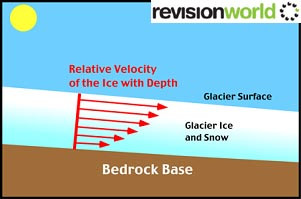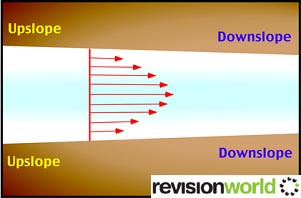Movement of Glaciers
Polar Areas
In polar areas, glacier ice movement is mainly by internal deformation in which ice crystals deform or slide over each other. Ice movement is very slow, only 1-2 cm per day, and there is minimal erosion as glacier remains frozen to bedrock.
Temperate glaciers in winter exhibit similar behaviour. Glacier flow is fastest in the centre and near the surface where friction is least effective.


Temperate Areas
Amount and type of glacier movement depends on whether the glacier is classified as warm (temperate) or cold (polar). ‘Warm ice’ glaciers in summer release large amounts of meltwater which facilitates ice movement by acting as a lubricant.
‘Cold ice’ glaciers remain frozen to the bedrock for most of the year.
In temperate areas glacier ice moves by one of four processes:
1. Basal sliding – movement increases pressure at base and thus amount of meltwater which further lubricates the ice. Ice may move 2-3 metres per day and erosion is active through abrasion.
2. Creep – occurs when ice meets an obstacle and leads to pressure melting on upstream side which aids flow. Meltwater refreezes on downstream side.
3. Extending-compressing flow – where the gradient is steep, the glacier moves faster and thins (extending flow) leading to reduced erosion but where the gradient is gentle, the glacier moves slowly and thickens (compressing flow) leading to increased erosive power.
4. Surges – glacier moves forward very rapidly (maybe 300 metres in a day) due to the build up of sub-glacial meltwater or perhaps large rock avalanches near the source. Surges may happen every 50 – 100 years.
